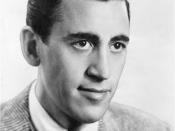Genevieve Patrick
"The Catcher in the Rye", published in 1951 by the Little, Brown and Company, is to date one of the most controversial books existing. It has been banned then reaccepted more times than anyone can count. Some schools still won't allow the book to be included into their curriculum. More conservative people believe it is too provocative and that it sends out the wrong message to impressionable young adults, yet other people believe it to be a relatable book about a troubled teen that provides a lesson for kids.
The first review I read about the "Catcher in the Rye" was published in the New Yorker by Louis Menand in 2001. He seemed to view the book in a reflective and positive light. He, among others, believes that Salinger chose to make Holden a universally relatable character for teens. Menand's interpretation of "The Catcher in the Rye" is that it is supposed to be the "literary equivalent of looking into a mirror for the first time".
However, Menand, rightfully, believes that the moral lesson of the book is that kids will grow out of their attitudes and that alienation is only a phase.
While the first review was enlightening, reflective, and positive, the second review I encountered in the New York Times titled "Get a Life, Holden Caulfield" written by Jennifer Schuessler was the complete opposite. Schuessler, contrastingly from Menand, considers the book to be outdated and unrelatable to today's readers. She explains that teenager's interests have evolved from what they used to be; therefore as time continues and more generations come into contact with the book, the less popular Holden Caulfield will be with the kids. Jennifer was grateful for the fact that in 2009 a federal judge granted a temporary restraining...


